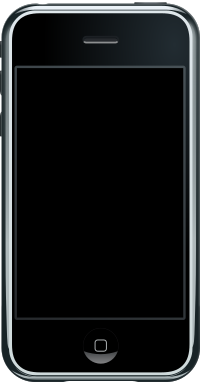 | |
 Front view | |
| Developer | Apple Inc. |
|---|---|
| Manufacturer | Foxconn (contract manufacturer)[1] |
| Type | Smartphone |
| Slogan | "Apple Reinvents the Phone with iPhone"[2] |
| Generation | 1st |
| First released | June 29, 2007 |
| Discontinued | July 15, 2008 |
| Units sold | 6,124,000 |
| Successor | iPhone 3G |
| Related | iPad, iPod Touch (comparison) |
| Form factor | Slate |
| Dimensions |
|
| Weight | 135 g (4.8 oz) |
| Operating system |
|
| CPU | Samsung 32-bit RISC ARM 1176JZ(F)-S v1.0[3] 620 MHz Underclocked to 412 MHz[4] |
| GPU | PowerVR MBX Lite 3D GPU[5] |
| Memory | 128 MB eDRAM[6] |
| Storage | 4, 8, or 16 GB flash memory |
| SIM | Mini SIM |
| Battery | 3.7 V 1400 mAh Lithium-ion battery[7] |
| Rear camera | 2.0 MP with geotagging (not GPS-based) |
| Display |
|
| Sound |
|
| Connectivity |
|
| Data inputs | |
| Model | A1203[9] |
| Website | Apple – iPhone at the Wayback Machine (archived June 29, 2007) |
| This article is part of a series on the |
| iPhone |
|---|
|
|
|
|
The iPhone[10] (retroactively referred to as the iPhone 2G[11] or iPhone 1[12]) is the first iPhone model and the first smartphone developed and marketed by Apple Inc. After years of rumors and speculation, it was officially announced on January 9, 2007,[13] and was released in the United States on June 29, 2007.
Development of the iPhone began in 2005 and continued in complete secrecy until its public unveiling at Macworld 2007. The device broke with prevailing mobile phone designs by eliminating most physical hardware buttons and eschewing a stylus for its finger-friendly touch interface. The iPhone instead featured only a few physical buttons and a touch screen. It featured quad-band GSM cellular connectivity with GPRS and EDGE support for data transfer, and it used continuous internet access and onboard processing to support features unrelated to voice communication. Its successor, the iPhone 3G, was announced on June 9, 2008.
The iPhone quickly became Apple's most successful product, with later generations propelling it to become one of the world's most profitable companies.[14] The introduction of the App Store allowed established companies and startup developers to build careers and earn money, via the platform, while providing consumers with new ways to access information and connect with other people.[15] The iPhone largely appealed to the general public, as opposed to the business community BlackBerry and IBM focused on at the time. By integrating existing technology and expanding on usability, the iPhone turned the smartphone industry "on its head".[16]
- ^ Dalrymple, Jim (July 28, 2018). "iPhone manufacturer to pay family of dead worker". CNET. Archived from the original on October 18, 2020. Retrieved March 31, 2020.
- ^ "Apple Reinvents the Phone with iPhone". Apple Newsroom. Apple. January 9, 2007. Archived from the original on April 19, 2019. Retrieved May 13, 2022.
- ^ Patterson, Blake (July 7, 2008). "Under the Hood: The iPhone's Gaming Mettle". touchArcade. Archived from the original on March 7, 2009. Retrieved March 20, 2009.
- ^ Dilger, Daniel Eran (March 20, 2008). "iPhone 2.0 SDK: Video Games to Rival Nintendo DS, Sony PSP". RoughlyDrafted Magazine. Archived from the original on May 16, 2009. Retrieved May 12, 2009.
- ^ Clarke, Peter (July 6, 2007). "IPhone code trail points to MBX graphics core". EE Times. Archived from the original on June 4, 2020. Retrieved March 31, 2020.
- ^ "Apple (Samsung S5L8900) applications processor with eDRAM". SUBM TechInsights. Archived from the original on July 15, 2010. Retrieved May 12, 2009.
- ^ "iPod and iPhone Battery and Power Specifications". iPodBatteryFAQ.com. Archived from the original on February 7, 2009. Retrieved May 12, 2009.
- ^ "iPhone – Tech Specs". Apple. July 14, 2007. Archived from the original on July 14, 2007. Retrieved January 19, 2009.
- ^ "Identify your iPhone model". Apple Inc. Archived from the original on September 24, 2011.
- ^ "Identify your iPhone model". Apple Support. Retrieved July 7, 2022.
- ^ Wong, Raymond (June 29, 2017). "What it's like to use the original iPhone in 2017". Mashable. Archived from the original on March 26, 2022. Retrieved March 26, 2022.
- ^ Rohmetra, Amogh (March 27, 2022). "iPhone 1 — A 'revolutionary' smartphone that debuted at the 2007 Oscars". ThePrint. Archived from the original on May 1, 2022. Retrieved May 1, 2022.
- ^ Dolan, Brian (December 18, 2006). "Timeline of Apple "iPhone" Rumors (1999–Present)". Fierce Wireless. Archived from the original on April 15, 2008. Retrieved February 17, 2008.
- ^ Tibken, Shara. "10 ways the iPhone changed our lives". CNET. Archived from the original on November 15, 2021. Retrieved November 15, 2021.
- ^ Kelly, Heather (June 29, 2017). "10 years later: The industry that the iPhone created". CNNMoney. CNN. Archived from the original on November 15, 2021. Retrieved November 15, 2021.
- ^ Mortillaro, Nicole. "On the iPhone's 10th anniversary, how it revolutionized smartphones". CBC. Archived from the original on June 15, 2022. Retrieved November 15, 2021.